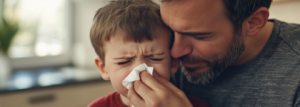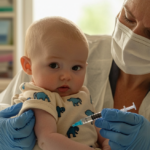
Agnieszka Stein: Gdy dziecko widzi, że rodzic reaguje na jego lęk niepokojem, zaczyna obawiać się jeszcze bardziej
Marianna Fijewska: Przeglądając najnowszą literaturę psychologiczną, wielokrotnie natknęłam się na stwierdzenie, że lęk wśród dzieci rośnie i staje się coraz większym problemem naszego społeczeństwa. Zgadza się pani z tym?
Agnieszka Stein: To bez wątpienia popularny pogląd, który jednak trudno jest zweryfikować. Często słyszy się, że kiedyś dzieci nie były tak bojaźliwe lub wrażliwe jak teraz, ale prawda jest taka, że to postawa dorosłych wobec dzieci była zupełnie inna. Dzisiejsi rodzice reagują na zachowania swoich pociech zupełnie inaczej niż 20 lat temu. Są znacznie bardziej wrażliwi i uważni na sygnały płynące od dzieci i bez porównania częściej zgłaszają się do specjalistów.
Jakie czynniki wpływają na rozwinięcie się lęku u dziecka?
Na lęk dziecka w dużym uproszczeniu mają wpływ trzy rzeczy – moment rozwojowy, temperament i środowisko. Zaczynając od pierwszego czynnika, można powiedzieć, że dla każdego etapu rozwoju dziecka charakterystyczne są inne strachy. Maluch przed pierwszym rokiem życia będzie bał się głośnych dźwięków lub obcych twarzy, zwłaszcza twarzy brodatych i twarzy w ciemnych nakryciach. Dziecko w wieku lat ośmiu będzie bało się chorób i śmierci. To wynika z tego, że żeby się czegoś bać, trzeba być w stanie to w ogóle zrozumieć. Kolejnym czynnikiem wpływającym na lęk jest temperament – dzieci różnią się poziomem wrażliwości. Ostatni czynnik to środowisko, co w przypadku małego dziecka oznacza przede wszystkim rodziców. Bardzo ważne jest to, jak podchodzą do lęku dziecka, na ile się tym lękiem opiekują, a na ile go bagatelizują lub nieświadomie potęgują.
W takim razie, jak powinien zachować się rodzic wobec lęku swojej pociechy?
Najpierw należy zaznaczyć, że sam fakt, że dziecko odczuwa lęk, jest zupełnie normalny. Lęk jest wpisany w nasze życie, wszyscy go przeżywamy. Pytanie, co z nim zrobimy. By dziecko potrafiło radzić sobie z lękami, potrzebuje pomocy i wsparcia ze strony ważnych dla siebie dorosłych.
Gdy dziecko widzi, że mama czy tata reagują na jego lęk niepokojem, zaczyna obawiać się jeszcze bardziej.
Czy to znaczy, że nad lękiem dziecka pracuje pani przede wszystkim z rodzicami?
Tak. Zdarza się, że po jakimś czasie zaczynam pracować także z dzieckiem, ale nigdy od razu. Na pierwszym spotkaniu zawsze pojawia się wyłącznie rodzic lub dwoje rodziców. Jeśli tematem konsultacji jest lęk dziecka, zaczynam rozmowę od ustalenia, co dla nich znaczą przeżycia dziecka. Bardzo często okazuje się, że rodzice boją się tego, że ich pociecha się boi. Wtedy wspólnie z nimi przyglądam się tym lękom. Staramy się je nazwać. Rodzice mówią, co dzieje się z ich emocjami i co dzieje się w ich ciele, gdy pojawia się temat niepokoju dziecka. Uczę ich, jak opiekować się swoim własnym lękiem, po to by potrafili zaopiekować się lękiem córki czy syna.
Na czym polega opieka nad lękiem?
Nie jestem w stanie wiedzy na temat swojej pracy streścić w kilku zdaniach. Mogę podać przykład tego, co robię. Otóż, jedną z technik opieki nad lękiem jest właśnie przyglądanie się mu i rozmowa o stresorze. Dziecku, które odczuwa lęk, należy poświęcić uwagę, potraktować jego emocje poważnie, nawet jeśli lęk wydaje się nieracjonalny. Zadaniem rodzica jest towarzyszenie dziecku w jego emocjach. Można to robić poprzez nawiązywanie rozmowy: „Opowiedz mi, czego się boisz”, „Co jest w tym najbardziej przejmujące?”, „Co twoim zdaniem może się stać?”, „Co się teraz dzieje z twoim ciałem?”.

A co zrobić, gdy dziecko po prostu nie chce rozmawiać lub gdy jest jeszcze za małe na rozmowę?
W przypadku młodszych dzieci kluczowe jest ukojenie fizyczne – złapanie za rączkę, przytulenie… Co do starszych dzieci, myślę, że każde w jakimś zakresie chce rozmawiać, ale rozmowa nie zawsze jest łatwa. To sytuacja, w której obie strony uczą się siebie nawzajem. Gdy dziecko odmawia odpowiedzi na pytania o swoje samopoczucie, rolą rodzica jest obserwowanie sytuacji – może zamiast rozmowy dziecko szuka uwagi i trzeba mu ją poświęcić, a może właśnie fizycznego ukojenia i trzeba je po prostu przytulić?
Jaki jest najczęstszy błąd popełniany przez rodziców w sytuacji, w której dziecko odczuwa lęk?
To, z czym najczęściej się spotykam, to powtarzanie dziecku, że nie ma się czego bać. Takie sformułowanie jest nie tylko nieskuteczne, ale niesie za sobą komunikat dla dziecka, że jego emocje są w jakiś sposób nie w porządku. W radzeniu sobie z emocjami dużo bardziej pomaga przyglądanie się im i próba zrozumienia.
Zdarza się też, że rodzice udają, że w ogóle nie widzą lęku dziecka. Wtedy dziecko boi się coraz bardziej, a strach jest coraz bardziej widoczny. Jeśli rodzice dalej odwracają wzrok, dziecko zaczyna wyrażać swój strach np. poprzez złość lub poprzez ciało.
Właśnie, jakie są objawy psychosomatyczne lęku u dzieci?
Najczęściej to ból brzucha, ból głowy, zawroty głowy, albo nieustanne chodzenie do toalety zwłaszcza podczas lekcji, gdy lęk związany jest ze szkołą.
W magazynie „Journal of Clinical Psychology” opublikowano badania, których autorzy (O’Connor, Holly, Chevalier, Pincus i Langer) używają terminu accommodating children’s anxiety. Termin ten można przetłumaczyć jako wygaszanie dziecięcego lęku i, w kontekście badania, oznacza on: angażowanie się opiekunów w ułatwianie dziecku unikania bodźców wywołujących lęk oraz w łagodzenie cierpienia spowodowanego lękiem. Wyniki badań są dość paradoksalne – okazuje się, że strategie związane z unikaniem lęku, mogą ten lęk potęgować, ponieważ dziecko nie uczy się w żaden sposób radzenia sobie z napięciem.
Lęk ma to do siebie, że gdy go unikamy, rośnie w siłę. Na radzenie sobie z nim nie ma jednej dobrej strategii, a strategia związana z unikaniem nie zawsze jest zła. W przypadku, gdy dziecko boi się rzeczy, którą w naszej codzienności da się omijać, np. węży, warto taką strategię stosować. Unikanie nie powoduje w tym przypadku żadnych negatywnych konsekwencji w przyszłości. Jeśli jednak mamy do czynienia z lękiem przed szkołą, rówieśnikami, czy popełnieniem błędu, unikanie jest niemożliwe. Wtedy rolą rodzice jest towarzyszenie dziecku i wspieranie go w przeżywaniu lęku.
Czy z pani obserwacji wynika, że istnieje jakiś najczęstszy bodziec wywołujący lęk u dzieci?
Nie prowadzę statystyk. Rzeczy wywołujące lęk u dzieci są bardzo różne i zależą głównie od ich etapu rozwoju.
Pytam o to, ponieważ myślałam, że może jedną z takich rzeczy jest rozstanie rodziców. Zwłaszcza teraz. Kolejne kraje europejskie publikują raporty, z których wynika, że w ostatnich miesiącach napłynęło znacznie więcej wniosków rozwodowych, niż w latach ubiegłych, co eksperci wyjaśniają oczywiście pandemią i wynikającą z niej szczególną sytuacją psychologiczną
Powiedziałabym, że znacznie częściej sytuacją wywołującą lęk u dziecka jest konflikt rodziców, a nie sam moment rozstania. Paradoksalnie rozstanie może być czymś, co ten lęk zmniejszy lub sprawi, że rodzice w ogóle zauważą, że dziecko ma problem.
Gdy partnerzy toczą konflikt, dziecko często nie może powiedzieć, że czegokolwiek się boi, ponieważ nie zostanie usłyszane. Zajęci własnymi problemami rodzice nie mają miejsca i przestrzeni, by udzielić mu emocjonalnego wsparcia.
W tym przypadku spotkania zaczynamy się od ustalenia, nad czym mamy pracować, co chcemy osiągnąć, na czym polega trudność dziecka i jakie strategie będą najlepsze.
Obranie wspólnego frontu musi być trudne, gdy dwoje ludzi jest w aktywnym konflikcie.
Nie zapominajmy, że partnerów łączyło kiedyś uczucie i więź. Staramy się wrócić na wspólną płaszczyznę. Mimo silnych i trudnych emocji wobec siebie nawzajem, rodzice, którzy pojawili się w moim gabinecie, zwykle zgadzają się co do jednego – oboje chcą chronić dziecko przed negatywnymi skutkami swojego rozstania. Sęk w tym, by tę strategię ochronną uwspólnić, i współpracować ze sobą, zamiast walczyć.
Na początku naszej rozmowy powiedziała pani, że lęk jest częścią naszego życia. Każde dziecko odczuwa jakieś lęki – przed ciemnością, przed wizytami u lekarza lub pająkami. Co zatem powinno być sygnałem dla rodzica, że pora zgłosić się do specjalisty?
Rodzic może zgłosić się do specjalisty, zawsze wtedy, gdy coś zaczyna go niepokoić.
Po prostu?
Po prostu. Tak jak mówiłam – jeśli rodzić będzie się niepokoił lękiem dziecka, dziecko przestraszy się jeszcze bardziej. Powstanie zupełnie niepotrzebne samonapędzające się koło lęku, którego można by uniknąć.





































